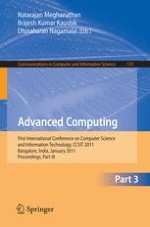2011 | Buch
Advanced Computing
First International Conference on Computer Science and Information Technology, CCSIT 2011, Bangalore, India, January 2-4, 2011. Proceedings, Part III
herausgegeben von: Natarajan Meghanathan, Brajesh Kumar Kaushik, Dhinaharan Nagamalai
Verlag: Springer Berlin Heidelberg
Buchreihe : Communications in Computer and Information Science
